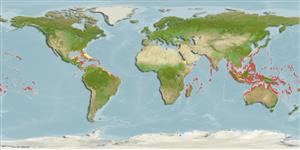Common names from other countries
Classification / Names / Names
Populärnamn | synonymer | Catalog of Fishes (gen., sp.) | ITIS | CoL | WoRMS
Environment: milieu / climate zone / depth range / distribution range
Ekologi
; djupintervall 0 - 20 m (Ref. 4). Tropical; 33°N - 36°S, 97°W - 135°W (Ref. 4)
Indo-Pacific and Western Atlantic.
Length at first maturity / Size / Vikt / Age
Maturity: Lm ? range ? - ? cm Max length : 20.0 cm TL hane/ej könsbestämd; (Ref. 4)
It has lengths of 20 cm, maximum total length; between 2 and 9, carapace length (Ref. 4). Taken at depths from 0 to 20 m, in coral or stone reefs with a sandy bottom. It is nocturnal and in the daytime hides in crevices, sometimes in small groups (Ref. 4). Also on rubble (Ref. 97531). Scyllarids are commonly considered to be opportunistic omnivorous (Ref. 106411). Aquarium observations indicate that they may open bivalves (Ref. 102680).
Life cycle and mating behavior
Könsmognad | Reproduktion | Lek | Ägg | Fecundity | Larver
Members of the order Decapoda are mostly gonochoric. Mating behavior: Precopulatory courtship ritual is common (through olfactory and tactile cues); usually indirect sperm transfer.
Holthuis, L.B. 1991. (Ref. 4)
IUCN Red List Status (Ref. 130435)
CITES status (Ref. 108899)
Not Evaluated
Not Evaluated
Human uses
Fiskeri: kommersiell
| FishSource | Sea Around Us
Verktyg
Ytterligare information
Age/Size
Tillväxt
Length-weight
Length-length
Morfologi
Larver
Abundans
Internet-källor
Estimates based on models
Preferred temperature
(Ref.
115969): 25.6 - 29.3, mean 28.1 (based on 3695 cells).
Vulnerability
Low vulnerability (10 of 100).
